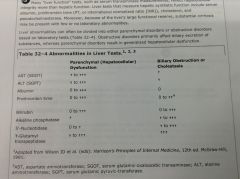![]()
![]()
![]()
Use LEFT and RIGHT arrow keys to navigate between flashcards;
Use UP and DOWN arrow keys to flip the card;
H to show hint;
A reads text to speech;
17 Cards in this Set
- Front
- Back
|
what percentage of the livers oxygen requirements are provided by the portal vein and hepatic artery?
|
hepatic artery: 45-50%
portal vein: 50-55% |
|
|
which coagulation factors are produced by the liver?
|
all of them except factor 8 and vWF
|
|
|
which factors are vitamin K dependent?
|
2 (prothrombin)
7 9 10 |
|
|
what do many "liver function tests" actually reflect?
|
hepatocellular integrity rather than liver synthetic function
|
|
|
what tests measure synthetic function?
|
serum albumin
PT/INR cholesterol pseudocholinesterase |
|
|
what is an albumin <2.5 usually indicative of?
|
can be:
chronic liver disease acute stress severe malnutrition can also be due to losses from nephrotic syndrome or the GI tract |
|
|
what does the PT measure and what is its normal value?
|
measures the activity of:
fibrinogen prothrombin factors 5, 8, 10 normal is 11-14 sec |
|
|
changes seen due to the stress response to surgery
|
surgery and trauma cause elevated circulating levels of catecholamines, glucagon, and cortisol, which cause mobilization of carbohydrate stores and proteins causing hyperglycemia and a negative nitrogen balance (catabolism), respectively
|
|
|
what can all opioids do?
|
cause spasm of the sphincter of Oddi and increase biliary pressure
|
|
|
what is the usual cause of elevated LFTs postoperative?
|
underlying liver disease or the surgical procedure itself
|
|
|
general overview of liver tests
|
the most common ones are neither sensitive or specific, and no 1 test evaluates overall hepatic function but instead 1 aspect of hepatic function, which must be interpreted in context
|
|
|
what do most "LFTs" actually reflect?
|
hepatocellular integrity rather than synthetic function
|
|
|
which tests measure synthetic function?
|
serum albumin
PT/INR cholesterol pseudocholinesterase |
|
|
when do these tests of synthetic function become abnormal?
|
since the liver has a large functional reserve it takes substantial cirrhosis for them to become abnormal
|
|
|
how can liver abnormalities be divided?
|
by lab tests into either parenchymal or obstructive
|
|
|
what's the general difference?
|
obstructive disorders primarily affect biliary excretion of substances, whereas parenchymal reflect generalized hepatocellular dysfunction
|
|
|
LFT values for parenchymal vs. obstructive disorders
|

basically with parenchymal dysfunction AST, ALT, albumin, and PT will be either slightly to very elevated, whereas they will be only mildly elevated if at all in obstruction (though albumin won't ever change in obstruction)
alk phos can be very elevated in obstruction but not in parenchymal disease, and same with 5'-nucleotidase |

